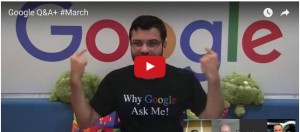There was a live Q&A recently involving some major figures in the digital marketing and SEO world, and also crucially included Google’s Andrey Lipattsev, the Search Quality Senior Strategist at Google Ireland. Andrey provided some informative insights about what should and shouldn’t work regarding ranking signals and gave a refreshingly straightforward answer to a very straightforward question.
Responding to recent Google statements that the new so-called Google RankBrain (more later) was one of three main ranking signals, SEO expert Ammon Johns suggested to Lipattsev that, knowing what we know about RankBrain, it would surely be beneficial to everyone if we also knew what the other two signals were.
And surprisingly, Andrey Lipattsev, obliges…
“It’s content and links pointing to your site.”
Ammon Johns followed that up with, “In that order?” To which Liplattsev replies, “There is no order.”
Content and links are no surprise, but Google’s RankBrain might be new to some and is worth expanding on as this is their latest initiative to defeat spam and improve the relevancy of search results for users.
What is Google’s RankBrain?
RankBrain is Google’s name for a machine-learning artificial intelligence system that’s used to help process its search results. RankBrain is part of Google’s overall search “algorithm,” a computer program that’s used to sort through the billions of pages it knows about and find the ones deemed most relevant for particular queries.
There may be various updates to the algorithm which justify their own name:
Penguin which aims to catch sites deemed to be spamming its search results, in particular those doing so by buying links or obtaining them through link networks designed primarily to boost Google rankings.
Panda which aims to reward quality websites that provide a good user experience with better rankings on search engine results pages.
The overall algorithm is called Hummingbird. It is paying more attention to each word in a query, ensuring that the whole query — the whole sentence or conversation or meaning — is taken into account, rather than particular words. The goal is that pages matching the meaning do better, rather than pages matching just a few words.
Google RankBrain is a machine learning artificial intelligence system, the use of which by Google was confirmed on 26 October 2015.
RankBrain uses artificial intelligence to embed vast amount of language into mathematical entities called vectors. If RankBrain sees a word or phrase it isn’t familiar with, the machine can make a guess as to what words or phrases might have a similar meaning and filter the result accordingly, making it more effective at handling never-before-seen search queries.
RankBrain interprets the user searches to find pages that may not have contained the exact words that were used in the user search query. When offline, RankBrain is given batches of past searches and learns by matching search results. Once RankBrain’s results are verified by Google’s team the system is updated and goes live again.
This is all part of Google’s bid to make the language of the web more natural, so it widens the market and usability of the search engine by non-techie types. It also means that dubious SEO techniques such as keyword stuffing should become a thing of the past as Google would probably prefer writing to be natural and communicate effectively.
Keywords will continue to be important but exact matching to a query should become less important over time.




